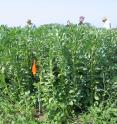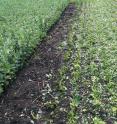One crop, two ways, multiple benefits
Nitrogen fixation is one of the best examples of cooperation in nature. Soil microbes - naturally occurring bacteria in the soil - work with plants to pull nitrogen from the air. They turn the nitrogen into a form the plant is able to use. In return, the plant lets the microbes eat some of the sugars it makes. Faba beans (also called fava beans) are one example of plants that work with soil microbes in this manner. These dried beans are part of a food group known as pulses. Their ability to work with microbes to fix nitrogen is a highly desired trait. It means growers can apply less nitrogen fertilizer to their fields.*
Newton Lupwayi and his research team work with legumes and pulses in Alberta, Canada. Alberta has terrific conditions for pulse crops: good soil (and microbes), good average temperatures, and good average rainfall. The team recently published research about the effects of using faba beans in two different ways to increase soil health in Canadian soils.
Says Lupwayi, "Pulse crops are grown in the Canadian prairies because of their agronomic, economic and environmental benefits. They are recommended to be grown once every four years."
Typically, organic growers plant pulse crops solely for their nitrogen-fixing ability and use them as green manure. In this process, there is no sale from the field's pulse crop. The crop is seeded as usual, but cut down after the flowers blossom and before seed growth begins. The leafy green part of the plant remains on top of the soil as cover or lightly tilled into the soil. The following year, growers plant a non-legume crop, such as wheat. This second crop benefits from the increased nitrogen in the soil.
The research compared this green manure technique to a traditional program of growing the beans to maturity for harvest and sale. Pulse crops grown to the seed-harvest stage created more nitrogen in the soil. This is because their roots were working in the soil longer and had more time to fix nitrogen.
These findings suggest growers should adjust their use of nitrogen in the years after a pulse crop. "Residues of pulse crops grown to the seed-harvest stage may not release much nitrogen in the first year after harvest, but they do release nitrogen for several more years," says Lupwayi. "Right now, most growers are not taking that extra release into account. Fertilizer recommendations should take the slow-release nitrogen into account to avoid applying excess nitrogen."
This research has multiple benefits: saving money on the cost of fertilizer, and reducing the chances that excess nitrogen fertilizer will run off into nearby water bodies. Excess nitrogen runoff can contribute to water pollution, an environmental concern.
In addition, says Lapwayi, "Growing a different crop from one year to another can break the pathogen cycle. This reduces the cost of disease-control chemicals, and is especially important to organic growers."
The study also found pulse crops increase the amount of carbon in soil
"Soil organic carbon is very important for soil health and quality," says Lupawayi. "It affects soil physical, chemical and biological properties. It improves soil quality."
Source: American Society of Agronomy
Other sources
- One crop, two ways, multiple benefitsfrom Science DailyWed, 6 Jan 2016, 18:55:51 UTC
- One Crop, Two Ways, Multiple Benefitsfrom Newswise - ScinewsWed, 6 Jan 2016, 17:52:21 UTC
- One crop, two ways, multiple benefitsfrom PhysorgWed, 6 Jan 2016, 17:30:34 UTC
- Indoor Gardeners: Potting Soil Better Than Backyard Soilfrom Newswise - ScinewsMon, 4 Jan 2016, 17:01:33 UTC

